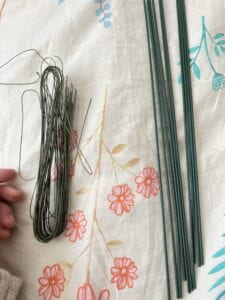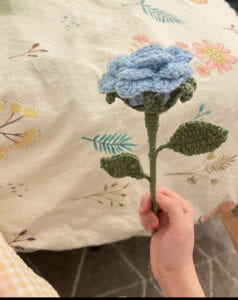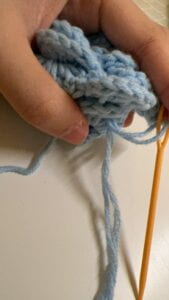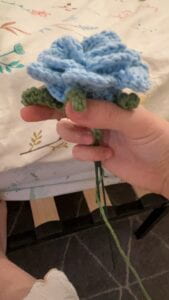Xinran Shen: Midterm Portfolio – #6 Touch Object
Project Description:
The theme of this work used to be “unattainability”. I chose to crochet a blue rose because it is a rare species, but given that the modality is a touch object, tactile feelings are playing a more significant role than the visual perception, which gives the audience the information that this rose is blue. In other words, I would have to make this rose tactilly interesting, instead of just a normal rose.
Documentation:
Insert images of your final tactile graphic here. Include alt-text. Also include design / construction / fabrication images, with alt-text and any photo captions that would be helpful in showing your process.




Visual Description:
To interact with this rose, start from the bottom of the stem, feel the unevenly wrapped yarn, and touch along the stem… Feel the thinner stems growing from it, and the fragile leaves. Move to the top, feel the lovely flower base, and finally, the actual flower head. The petals are thick and feel safe, as if they were moving creatures.
Reflection questions:
To do that, I researched a couple of different crochet patterns of making a rose. To make the rose, the materials needed are thicker sticks for the stem, wires and green yarn for the leaves, more green yarn for the flower base, and blue yarn for the flowers. Many people crochet the flower petals one by one and glue them on each other, and then directly bend and poke the thicker sticks through the flower base and the flower. This way of assembly makes the final flower look almost flawless with thin stems, but also look vulnerable like some stereotypical images associated with roses (living in a glass shell..)
I wonder how my rose could feel different than a normal rose when an audience touches it, while still being able to recognize it’s a rose or at least a flower. Crochet as my favorite modality allows a lot of room to experiment and make mistakes, and after trials and errors (disassemblying and reassembling…), this is my final rose:
- I tried to make this feel like a trough and rough rose, and give it a hand-made quality. Before directly poking the stick through the flower and the base when connecting the stem, I used another wire to first connect the flower and the stem, then wrapped the long ends of the wire around the stick. After wrapping the green yarn around all of these, the stem looks a bit thicker than most of the final products provided by the online patterns.
- I didnt wrap the green yarn around the stick neatly, hopefully this creates a rougher texture.
- I curled some of the ends of the flower base so it feels more lively (my friend says it’s like an octopus). Some of them actually starts to curl itself after I finish making the base, so this part is not so hard.
- I am not very good at making leaves, and I already recrocheted it for a couple of times. But I guess the good thing is that because I am not good at it, the final product is very close to the kinda texture I want.
Although I tried to make the details of my rose tell it’s story, I think it excluded blind and low vision audiences and it would help to include a caption in braille to explain my feelings behind. For other people who are unable or inconvenient to hold the rose, this work might also be hard to experience. One way to include these folks is to use a bit of physical computing and connect my rose with a scent machine, which I have no idea how to do that. So I sprayed a bit of my perfume on it.
Something I wish I could’ve done with more time:
- Instead of simply using crochet, use other modalities for different parts of the rose. For example, if I know how to see, I might use silk for the flower parts or the leaves. Right now because there is only one texture, some information are left inexpressible with this modality.
- Add the thorns on the stem to make it tougher. As suggested by Annie the guest speaker!
- Add free form crochet to the flower if I have a good reason to do so. I didn’t do it this time because learning the pattern itself is already a little bit too much work for me… it’s harder than expected.